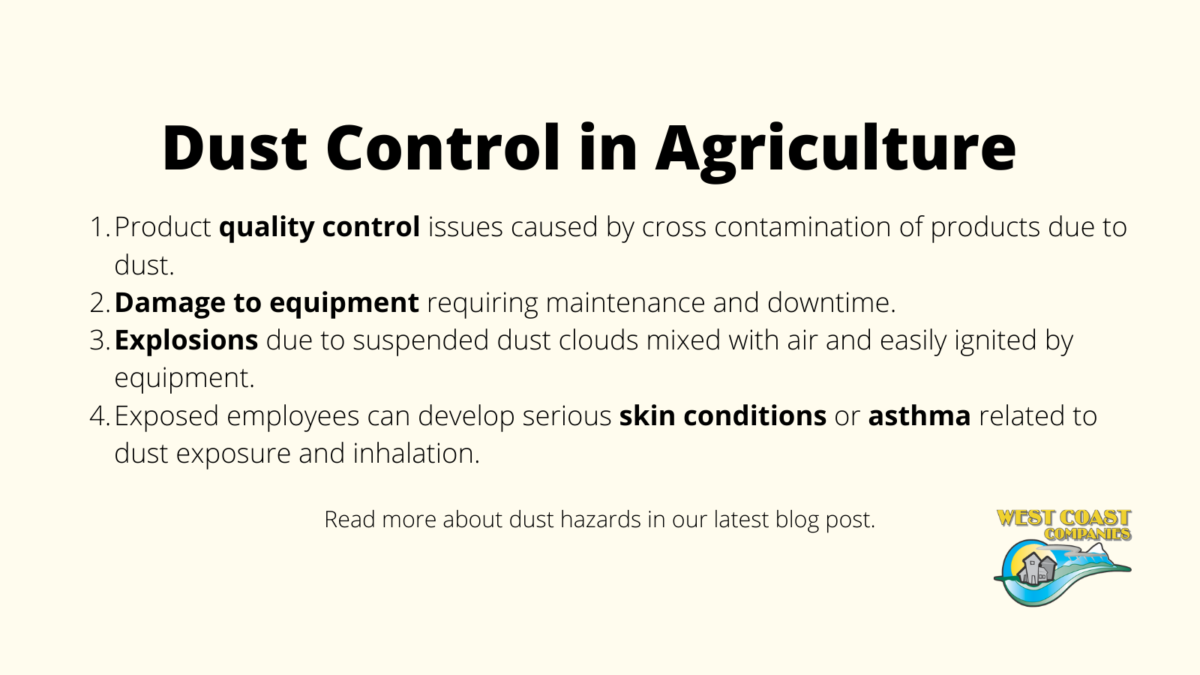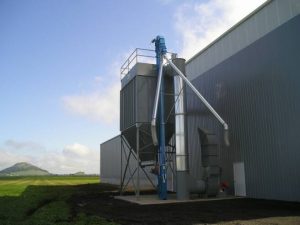
Agricultural Facilities: Dust Safety
Silos, grain bins, and the processing of agricultural material, for example grain, produce dangerous airborne particles and dust. These dust particles create numerous hazards to your employees, products, and facility, including:
- exposed employees can develop severe skin conditions or asthma related to dust exposure and inhalation,
- quality control issues caused by cross-contamination of products due to dust,
- damage to equipment requiring maintenance and downtime, and
- explosions due to suspended dust clouds mixed with air and easily ignited by equipment.
Managing the risks created by dust particles starts with conducting a dust hazard analysis (DHA) that will identify the characteristics of dust within your facility and test the dust explosivity. In addition, a DHA is helpful for an owner to understand what type of dust mitigation practices are needed within their facility.

Dust Control
Housekeeping
OSHA’s Grain Handling Standards require every grain handling facility to have a written housekeeping program to help pinpoint and mitigate safety risks. The program must include directions on:
-
- Inspection frequency
- Cleaning frequency
- Cleaning methods
- Spills and leak management
- Dust control equipment
Proper housekeeping practices ensure continuous measurement and trends of airborne particles and early identification of any changes. Regular interval inspections and cleaning will mitigate risks before dangerous dust levels are present.
Dust Control and Extraction Systems
As you explore solutions to capture and contain dust within your facility, knowing about the various system options is essential.
-
- Source capture
Source capture systems usually are primary dust control systems. They use source capture arms, slotted dust hoods, or smaller slotted hoods with side shields placed over the work area producing the dust. These systems are the first defense against dust as they remove it ‘at the source’ of contamination. - Enclosures
Creating enclosed areas for the source capture systems with curtains or walls can further minimize dust contamination. However, these should not interfere with the workspace and encompass the entire process area that creates dust. - Ambient ventilation
Ambient systems are used as stand-alone or secondary solutions alongside source capture and enclosure systems.
An ambient system is a centralized whole-facility solution that continually cleans and processes the air from the entire building. It can use one central air system with filters or multiple smaller collectors and is best suited to filter large entire work areas because they do not require hoods. Employees are still often required to wear personal protection equipment in ambient ventilation system environments because they do not remove particles from any breathing zones.
- Source capture
When looking for an equipment supplier for dust systems, it is paramount their service includes:
-
- the knowledge and experience of your products and processing equipment,
- knowledge about regulatory compliance for your facility,
- a full range of equipment for your dust control needs,
- testing services (in-house or with partners), and
- training for your employees on equipment.
Beyond managing and avoiding risks, many agriculture processing operators are subject to regulatory compliance. These often vary by jurisdiction, and therefore it is essential to know which standards apply to your facility. The most common standards come from the National Fire Protection Association (NFPA), which requires DHA’s for all existing and new processing facilities (NFPA 652 came into effect on September 7, 2020). The NFPA standards are commonly enforced by OSHA (OSHA General Duty Clause, Section 5(a)(1)) and therefore are a good starting point to understand regulatory compliance.
A well-designed, maintained, and operated dust collection system is an integral part of your facilities operations, your workers’ health, and regulatory compliance.
– – – –
Additional resources:
The National Feed and Grain Association provides a sample Housekeeping Program free online (page 4).
Donaldson Torit: Combustible Dust Management
OSHA Bulletin: Combustible Dust in Industry: Preventing and Mitigating the Effects of Fire and Explosions
OSHA: Agricultural Operations Guidance
NFPA: Standard on the Fundamentals of Combustible Dust


